Having such an intense focus on preserving and honoring the designs that defined the form (many of which have existed fundamentally unchanged since the 1920s) can make it wildly difficult to craft a unique voice within the idiom – which is why Chris Ferandez’s work is so impressive.
The tattoos Fernandez makes are firmly rooted in the past and to see his work is to see a piece of art divorced from time. Yet Fernandez’s work is instantly recognizable as his own and the personality he imparts upon the classic designs he so often interprets exists in uncanny harmony with his ability to stay true to the spirit of those designs. It’s a magic trick that musicians speak of when they discuss the rare breed of player that’s joined the proverbial One Note Club: Those you can recognize from hearing but one note. In the world of tattooing, Fernandez’s take on the classics is like that of a great blues or jazz player that carries the weight of tradition while letting their own personality have equal billing. For Fernandez, that magic trick has delivered him from apprenticeship and long term tenure starting at a startlingly young age at Miami, Florida’s premier shop, Ocho Placas Tattoo Company, to a station working alongside some of the best tattooers in the world at New York City’s hallowed Kings Avenue Tattoo – which is more than just an important shop adding to the Bowery’s rich tattoo history, but a cultural hub, repository of living history, and a gathering point for tattooing’s great innovators, elder statesmen, and rising stars. Its walls are covered in original works by the likes of Ed Hardy and Thom Devita and its books house rare, uncirculated flash by wildly influential artists like Daniel Higgs. It’s more than a tattoo studio: It’s the Bowery’s ink temple.
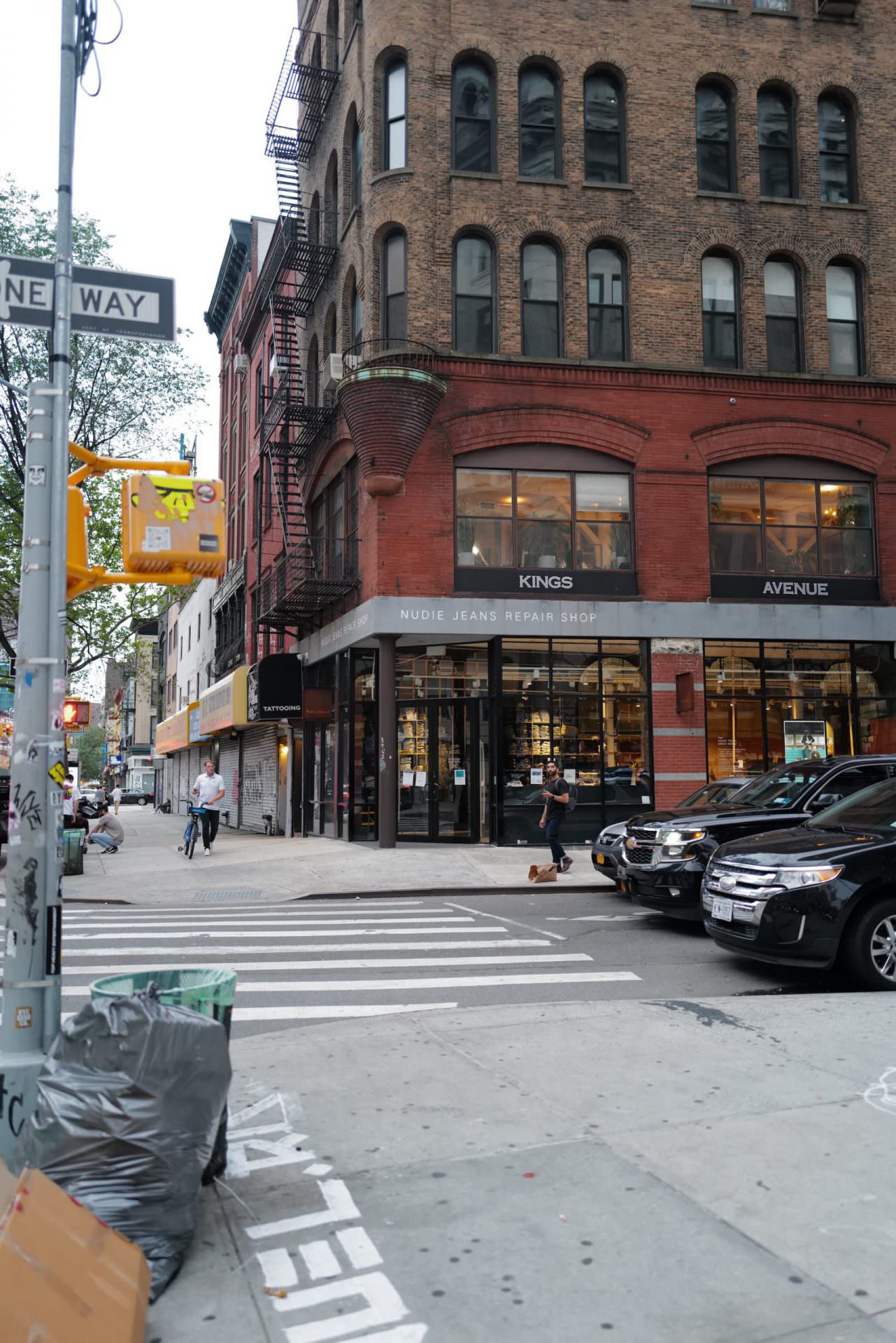
In the same way watch collectors appreciate that nuance and depth of detail can make all of the difference in the world from example to example and reference to reference, the nuance and detail that hides in plain sight in Fernandez’s work can be difficult to explain to the uninitiated. However, for those with a refined gaze, the little touches that make a Chris Fernandez tattoo unique, yet timeless, have earned him status within the industry as a rising star. And while he himself may scoff at the notion of stardom within the tattoo world, Fernandez’s books are consistently stacked for months with new and returning clients – many of whom have sought him out for big real estate projects like full sleeves or full back panels.
In this wide ranging interview, we get into Chris Fernandez’s head as an artist, discuss his path from graffiti artist and shop rat to a full time gig at one of the most important tattoo studios in the world, how a Rolex Submariner is the same as a Bert Grimm tiger, and what it means to be contributing to a new chapter of tattoo history in a place as important to the artform as the Lower East Side of New York City.
Tell us a little about how you entered the tattoo industry.
Chris Fernandez: Right before I turned 16, I really wanted to get my first tattoo. I had been hanging at Ocho Placas Tattoo Company in Miami a lot at the time and John Vale said he would do it, but my dad had to come in and sign off. My dad agreed and John did my first tattoo — which was a big oni on my shin. From that point on, I was legitimately in that shop every single day; I’d go get food for them, I’d run whatever errand I could just to have a reason to be at the shop. I’d run to get art supplies — anything. Eventually John Vale offered me an apprenticeship, but I was planning on going to art school for graphic design and illustration – so I initially turned John down because I thought I was going to be headed to school.
I learned a couple of months later that school was going to be too expensive and I didn’t get the scholarships that I’d applied for. I kept hanging around the shop and I was answering the phones, drawing flash off the walls, doing whatever I could to be involved while still painting graffiti and going to community college. John Vale asked me again if I was interested in apprenticing and I remember a friend who worked at the shop hit me up before and said “I think John might ask you again — don’t screw this up this time!” So in November of 2010, I started my apprenticeship at Ocho Placas working under John and Javier Betancourt. I apprenticed for a year and a half before I started tattooing, and I was tattooing clients by mid-January of 2012.
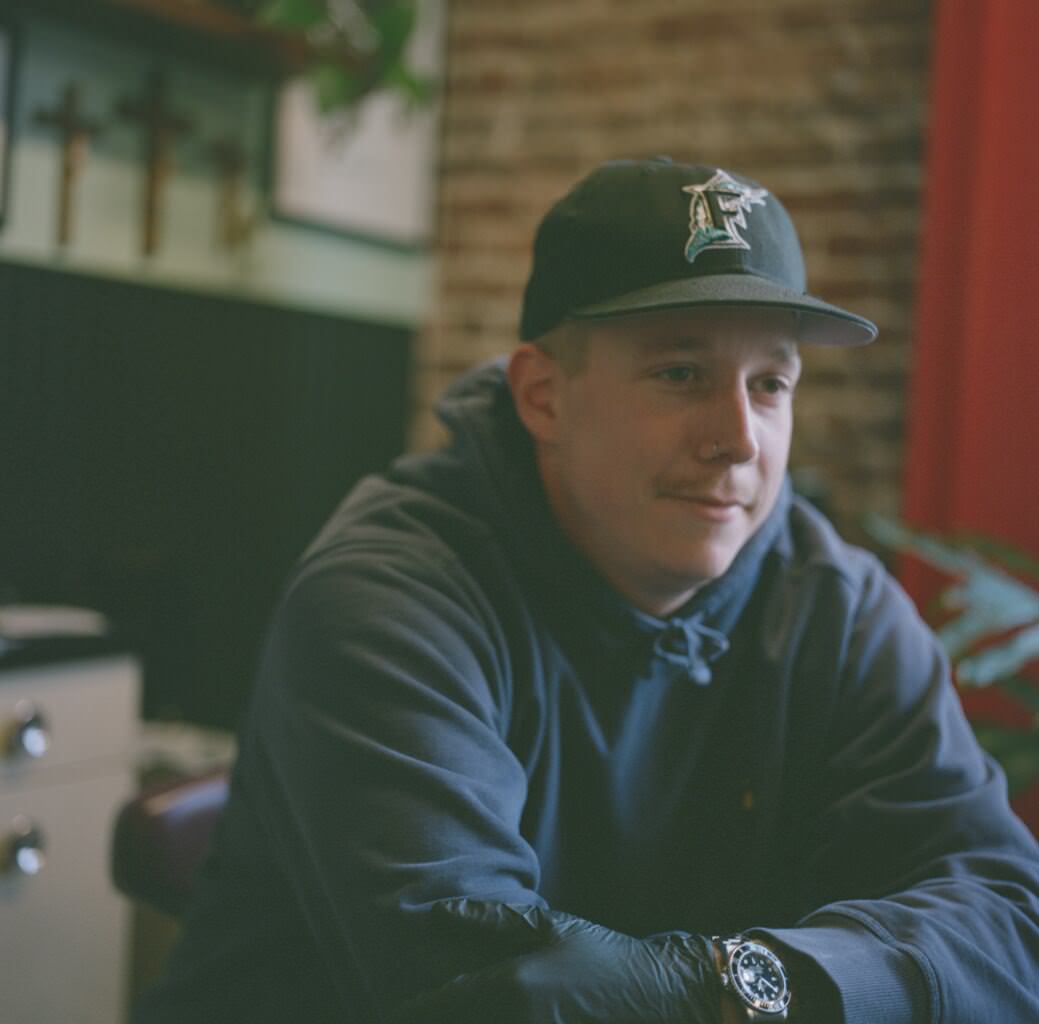
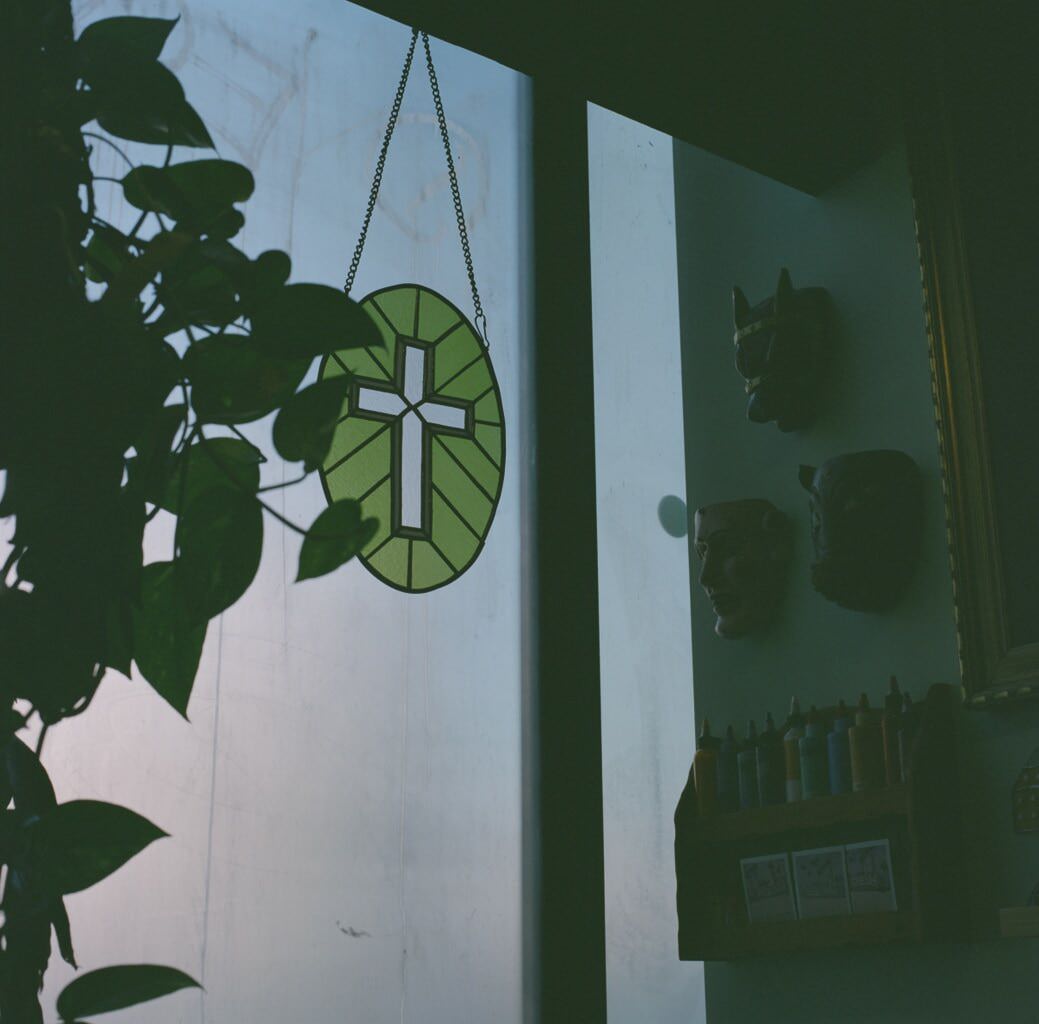
What about tattoos spoke to you first and loudest?
Realistically as a 16 year old kid, I just thought it was the coolest shit. I can’t really try to intellectualize what it was for me at that age. I think subconsciously, the power in the approach of Japanese traditional, American traditional — anything with a strong line holding it together got me. Something I realized much later is that the image itself — your art as a tattooer — has the ability to travel without you doing anything. I love that. If I make a painting, someone has to hang that thing on a wall and then get people to come and look at it or I have to put it somewhere that it’ll be seen. There has to be some kind of viewing context like an art show. When I do a tattoo, that thing is going to be seen every single day by somebody. That idea really grabbed me and when I painted graffiti, my favorite thing to paint was freight trains because I could go to the same spot in Hialeah every Sunday and paint five trains and in a month, I would go on Flickr or Photobucket and search my name and a photo would pop up of a train I painted that was in Ontario or Kansas or California. Those artworks would go on their own merry way and I never saw it again, but they were out there somewhere. It’s similar to tattoos in that there are thousands of tattoos that I’ve done that I will never see again, and I kind of like that. That tattoo is living its own life and being seen by people, and if I had a painting and I showed it in a gallery in New York or LA, it wouldn’t be seen by that many people. Even if I was really, really good.
Were you any good straight out-of-the-gate? Was it a prodigy situation?
I was exceptionally terrible! In fact, after my third tattoo, Javi sat me down and said “Yo, you’re not allowed to tattoo anymore. We’re stopping you because you’re not doing it right.” So I had started and then there was six months where I wasn’t allowed to tattoo, which was a real shot to the heart. I was super pissed at Javi at the time and I was really lit up to become the best tattooer I could be just to kind of shut Javi up. But he was totally right, I was doing terrible tattoos. The script changed and I got very serious and inspired after that.
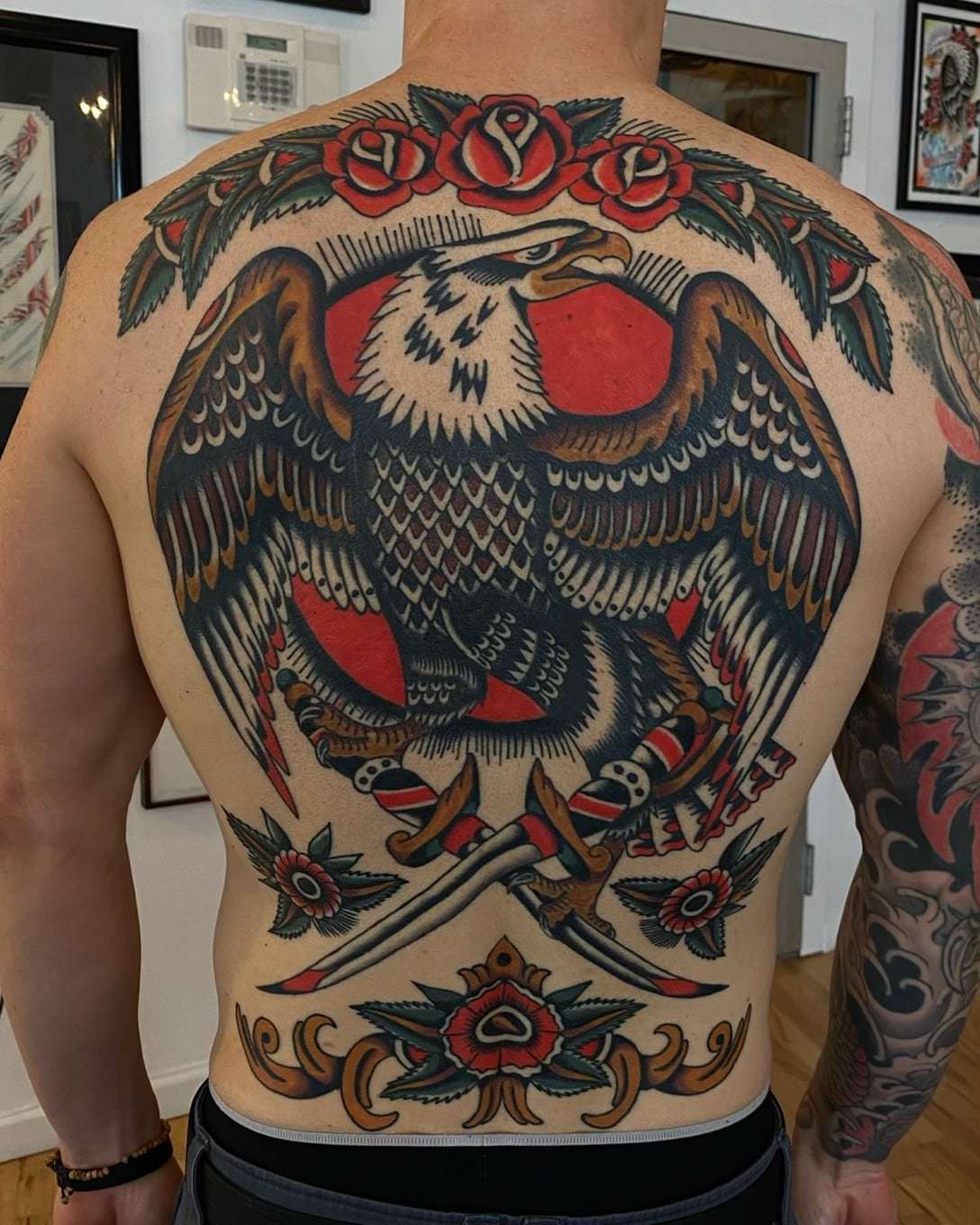
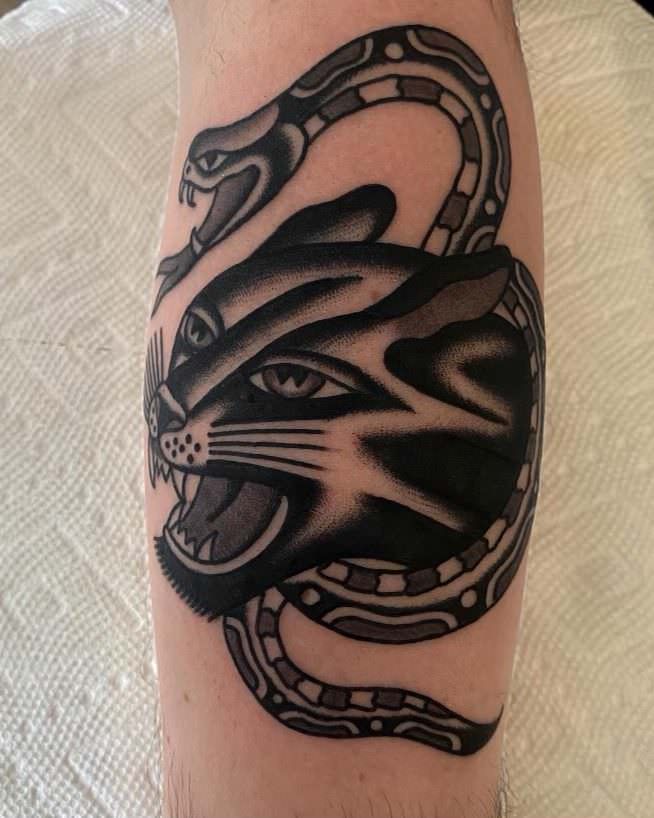
You’ve developed an immediately recognizable style that takes American traditional tattooing from a very specific time and adds a unique twist. Your style is timeless, but undeniably unique within American traditional tattooing. How did you develop that thing and how did coming up in Miami affect your style?
I like my tattoos to be very legible from far away, even if they’re very detailed up close. So I like a lot of high contrast areas and mixing really dark sections with really light ones or negative space, and that comes from my graffiti background. When I did graffiti, I wasn’t worried about how technical or detailed or complicated the image was, I cared about you being able to read what it said as a non-graffiti writer if you were four blocks away and driving 80 mph on the turnpike. Legibility has always been my thing. The other thing is I use colors with major contrasts; I started doing that in Miami because you’d tattoo a lot of skin that’s beat up by the sun or just tanned from living in Florida, so I had to make sure my tattoos still looked strong and bright on skin that’s weathered years in Miami. So the way I approach color and how bold I pack my color in was very much influenced by my clientele in Miami.
As far as how my work has changed over the years, people I’ve worked around — artists like Javi or Grez or Becca Genne-Bacon — have really influenced my approach and my style. When I travel, the work I love and see in person naturally works its way into my own stuff. When I see a good tattoo and say to myself ‘that’s the way that design is supposed to look,’ it seeps into what I do. Some artists I like who influenced my style recently are Nate Hudak, Ivan Antonyshev, and Zach Nelligan.
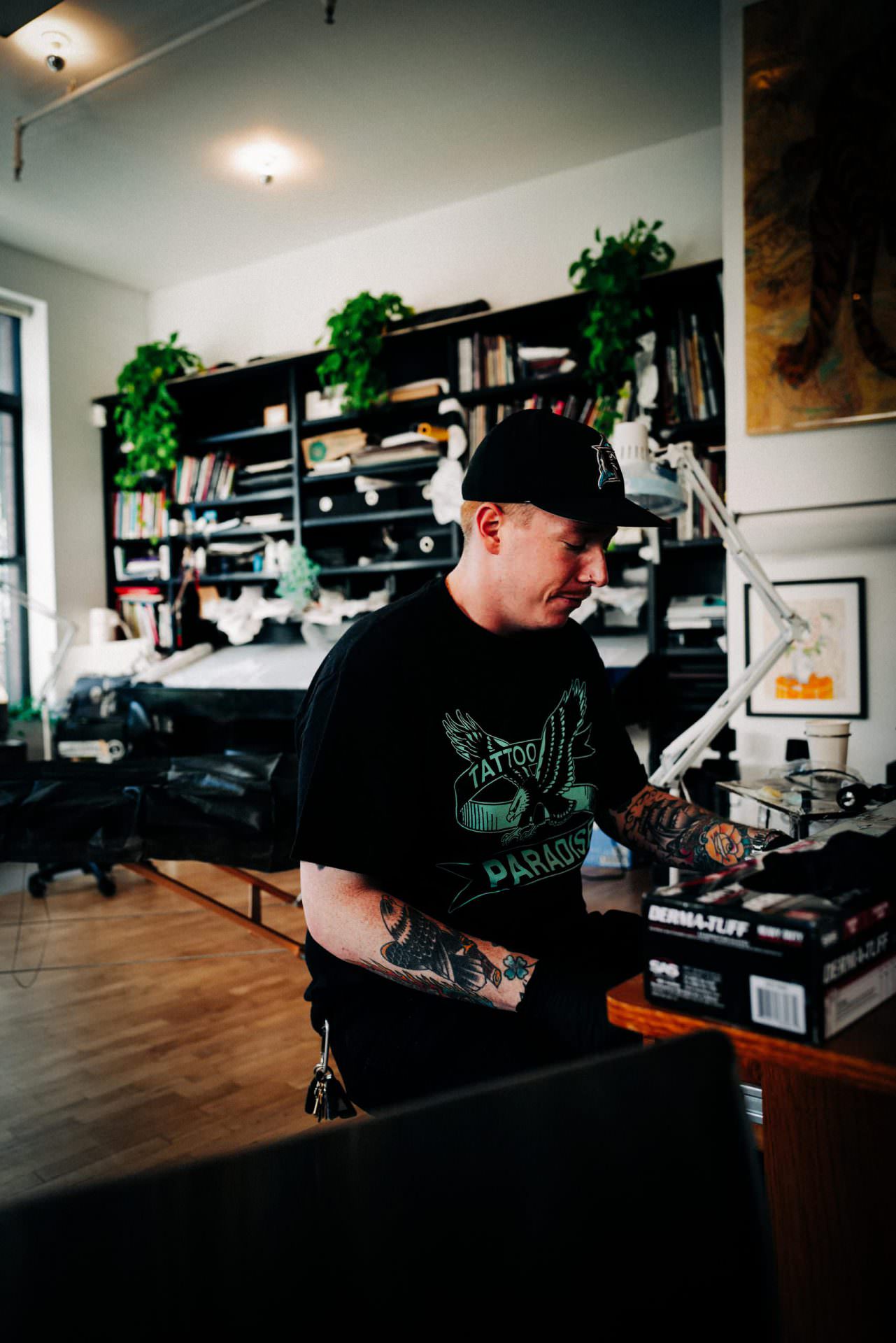
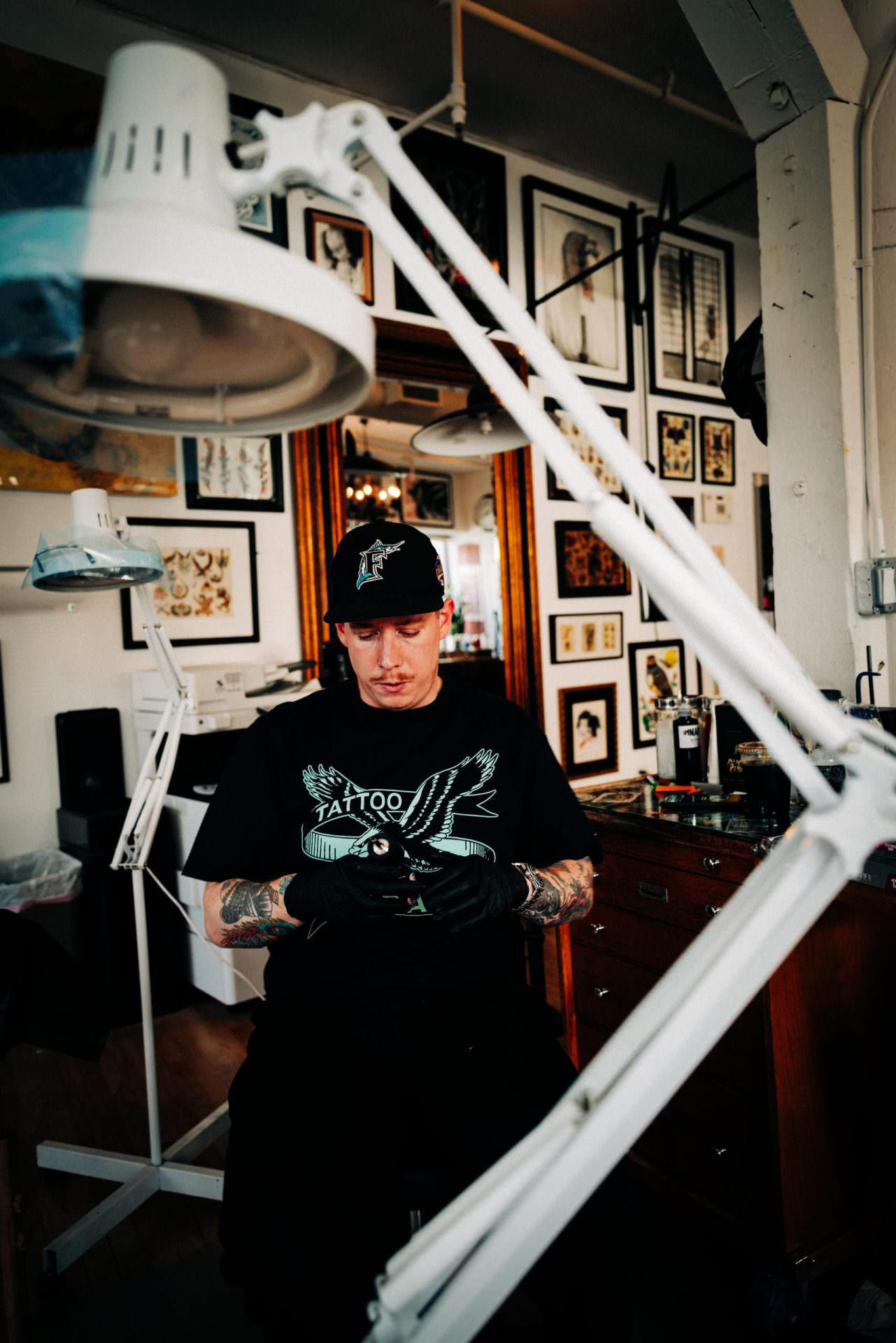
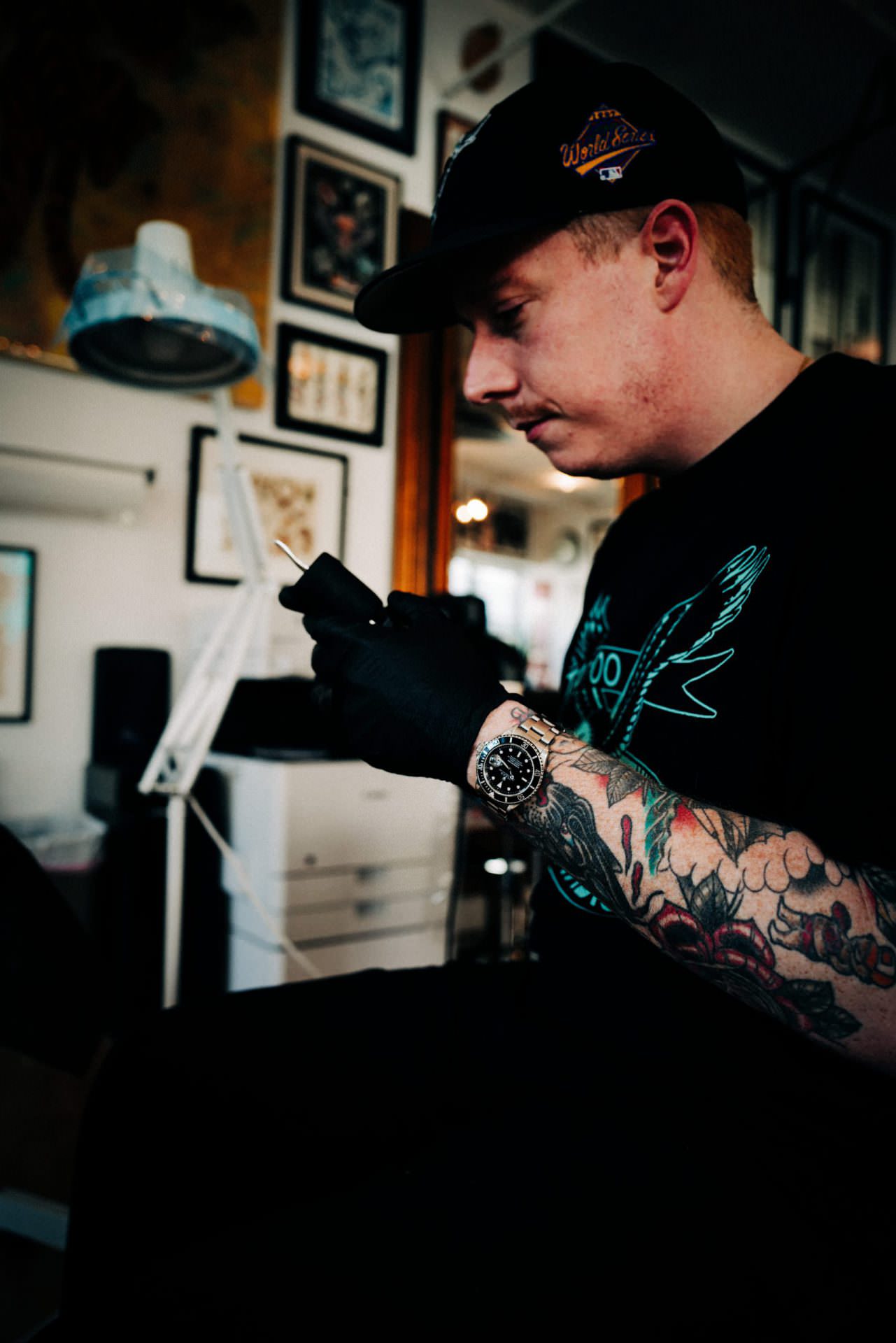
What drew you specifically to American traditional stuff? Obviously Javier does a lot of that and his influence is there, but what made it your whole focus?
It all comes back to the same things that drew me into graffiti: The power of this particular style of American Traditional.There’s something special to me about the strength of work with black shading that’s whipped out. The other thing is the actual speed of it; there’s a speed to traditional tattooing that’s part of the style and culture of these tattoos and they look like they were done quickly in a really cool way. Similarly to how I painted graffiti, traditional tattoos were whipped and drawn with speed so you could do as many tattoos as possible on sailors or whoever was coming into the shop that day — it was about being efficient. So the power and the speed of it was really interesting to me.
What do you think makes American traditional tattoos so relevant these days? You’re booked almost a half a year out and shops that specialize in that work like Smith Street are booked way out, too.
I think beyond it just being classic, it’s something everyone can relate to. Almost everybody grew up with a grandfather or an uncle or knew someone that had traditional tattoos. For me, it was the guys my dad worked with in the mechanic’s shop at a car dealership. They’d have an anchor on their forearm or something very relatable. All that imagery is so legible and understandable that it draws people in and a lot of people really like art that they can relate to and that they don’t have to intellectualize. I think the more you get into a specific artform – even a traditional one – the more you’re open to weirdness in it and the more open minded you get.
As far as relevance goes, realistically, it’s a trend – but it’s one that’s going to stay because the way you approach a traditional tattoo fundamentally really just works. They last and look good for a long, long time. Certain color realism approaches don’t look as strong for as long; I’m not saying that they can’t because I’ve seen some color portraits that really lasted, but it has a lot to do with how that tattoo is applied and how tattoo artists look after that tradition. If you look back at the last fifteen or twenty years, the style of American traditional tattooing overall has changed, it’s just been subtle.
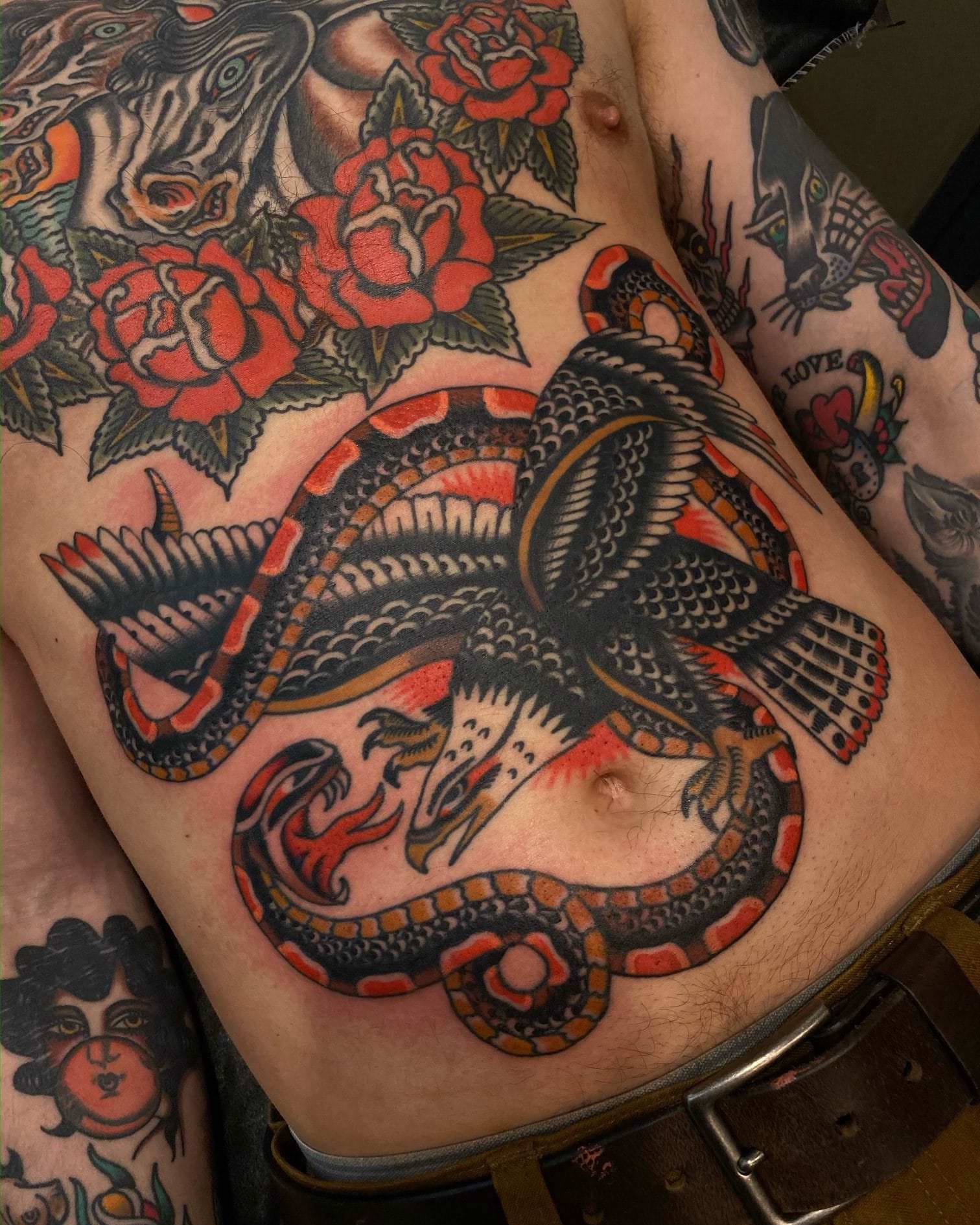

Can you elaborate on how it’s changed?
There are different styles that come from different times and different artists and specific cultures. There are styles that are very derivative of someone like Ed Hardy and have based a lot of their art off of that dynamic traditional tattooing. Ed Hardy brought more dynamics into traditional images and didn’t care so much about the speed of putting them on. Then there are people who base their designs off someone like Ben Corday’s stuff, who was tattooing at the turn of the century; Corday’s stuff is a little more linear and he used smaller lines because they had smaller needle groupings back then and they just didn’t have the same tools we do now – so they’d use thinner lines and do a lot more linear stuff which developed around the limitations of the tools. Then you have guys like Bert Grimm, whose stuff was simpler and almost folk arty. So people derive styles from these different important artists and they’ve changed around interpreting that work. And that kind of thing still happens with modern artists; you’ll have an artist that creates something special and there’s a big push to cop that thing, like in 2010, a lot of people were doing Spanish-style tattoos and a good example in my work is a modern-day influence for me is El Bara, who tattoos in Madrid, Spain. So while it’s still classic and some artists stick to their specific thing, the way people hone in on nuances and niches changes it overall.


I think it’s similar to the way that a watch layman probably isn’t going to pick up on the nuances that make a ‘60s Rolex Datejust a drastically different watch from a ‘90s one, they’re fundamentally the same thing, but the differences to people with a trained eye and a deep knowledge of these things immediately notice are everything.
There’s a lot of tattoo designs that people wear because they’ve got that classic look, but they may not see the nuances and differences, but there are small details that make a huge difference.
I don’t wear a Submariner because I’m into diving, but realistically it’s because I saw other tattooers I looked up to when I was younger wearing a similar watch and I was like “that’s badass!” That was my intro to watches – it was that simple and stupid! Now, I appreciate the actual specifics and details and nuances of Rolex Submariners and different references that I didn’t appreciate before, but it took something as simple as ‘Oh, that’s what that guy is wearing, I want to wear one’ to sink the hook in.
The Bert Grimm tiger, the Sailor Jerry swallow, the Ed Hardy panther – these things are all going to look good forever. The first time Ed Hardy drew a panther and the first Submariner they made defined that thing and while the small details have changed over the years – details on the clasp, finishing materials, case sizes, etc – these are both things that have remained fundamentally unchanged since they were first conceived.
Something the social media era has changed is how geographically specific tattooing is. The tattoos being made in New York or San Francisco once had their own thing and that’s changed because we all now have this ability to reference anything we want whenever we want. You tattoo in the Lower East Side of New York City, which has been home to no small share of extremely influential tattoo artists, from guys like Thom Devita to the generation of guys that Chris Garver came up in. Can you talk a bit about what being an American traditional-focused artist working in the LES means to you, what working at Kings Ave brings to your work considering what an important cultural hub it’s become in tattooing.
Tattooing in New York City in general – not even specifically on the Bowery or LES – but tattooing in New York City has been there since day one. You had guys like Charlie Wagner and Percy Waters here,and so many important artists were either based here or passed through New York — especially the Bowery because it’s always been a very transient area. To be really frank and maybe a little simple, it’s just really cool to be in the thick of it and there’s a magic to working on the Bowery that I really try to always keep in mind – especially when I’m doing very classic tattoo that maybe came out of a flash book or an old piece of flash. I try really hard to preserve some original aspects of it and keep the look of it true to its intention. For me, it always has to look a little fast; Thom Devita’s work was always about speed and beautiful designs that were done quickly, done well, and done with a certain level of respect for the design itself. At the end of the day, I am just a Miami kid working in New York and the novelty of that hasn’t worn off on me and I know that I am still technically an outsider here, but it feels really special to be here and doing it.
This shop is also a location where luckily I’ve been able to see the best-of-the-best tattooers come through there and work and it’s become a destination for a lot of people. Mike’s [Rubendall, owner] created a really cool thing with that and I think that’s a big part of why it has the name it does. So many top tattooers have come through there, it’s a special spot. As much as I feel like I’m a part of it, I feel like I enjoy being there and just experiencing the environment there just as much. I get to come in and work every day in New York City and that’s always been a dream of mine, and I’ve always paid attention to tattooing in New York – whether that be Mike Rubendall’s work, Grez’s, Chris O’Donnell’s, Chris Garver, or tattoos done here by Tony Polito back in the day. To be able to work side-by-side working with these guys and learn from watching them is special. Ed Hardy will come into the shop once a year or getting to interact with a guy like Mike McCabe and learn from a historian like that is really cool.
There’s also an aspect of getting to pay my respects to these older tattooers that came before me and there’s a level of respect and appreciation I have for them because I’m enjoying the fruit of the labors in a way. Tattoos weren’t always cool and now they’re really cool and I’m getting to enjoy that cultural climate, but it took a long time to get there and weren’t looked at as an entirely taboo or negative thing – so I definitely appreciate the work those guys put in to get it there and especially the contributions of New York’s guys.

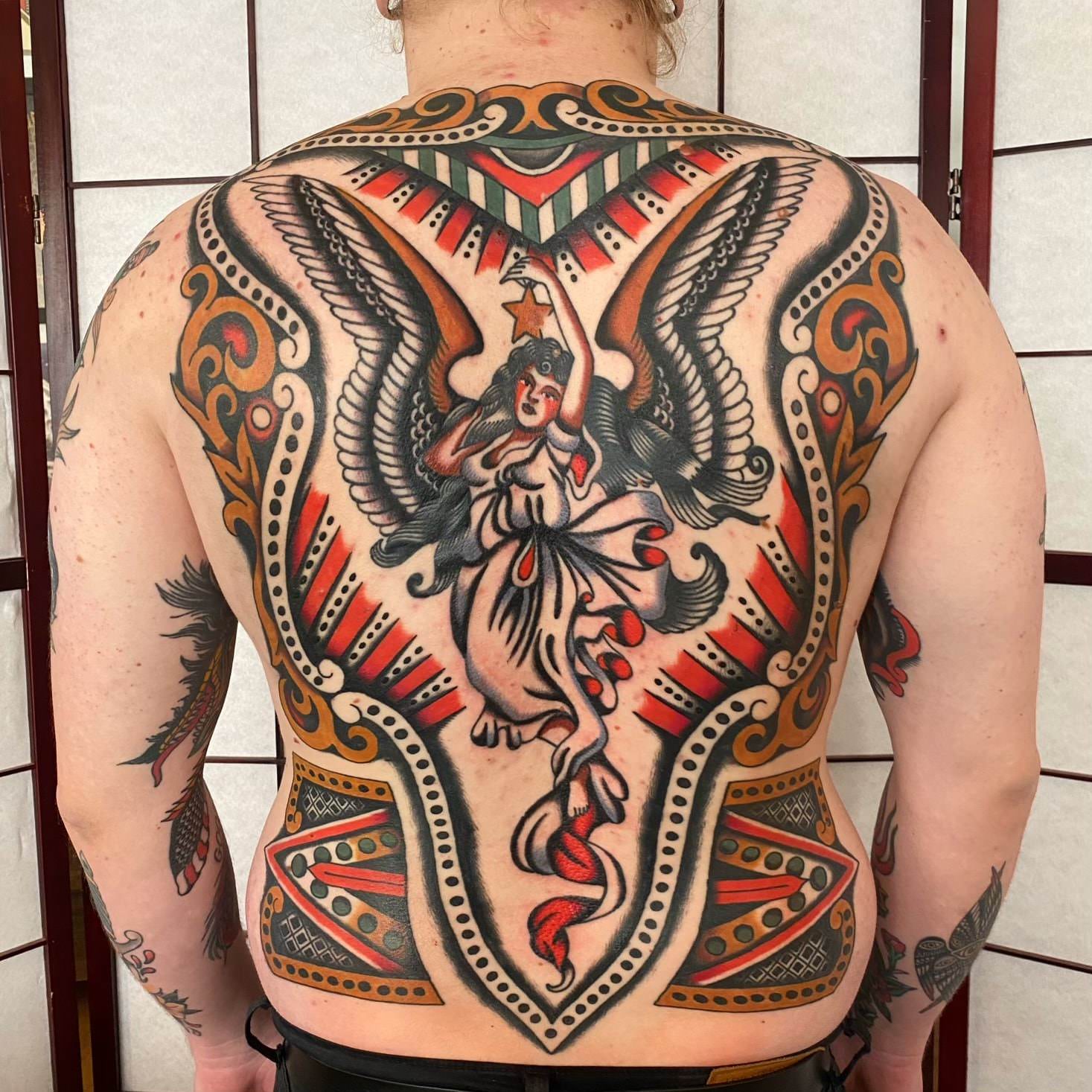

How do you stay inspired and keep progressing in such a traditional idiom?
That’s the weird thing that I struggle with sometimes, but also get to enjoy in a way. A tattoo of a rose or a wolf or a clipper ship, there are only so many ways you can tattoo these designs and you can get burnt out on that and you can’t just put the same one on everyone, but at the same time, you can! It can be just about the design and sometimes a client just wants the tattoo from me the way I do them, and it doesn’t matter if the person that came in the day before got one just like it, a lot of people just want to wear it because it’s a classic image and they like the way I do it. I’m providing them with a service at the end of the day and I’m not always here to serve myself as an artist. It can be like a musician getting tired of playing their hits and putting tons of effort into a new record, but people want to hear the old shit. There’s nothing wrong with that and you have to be thankful for the hits.

Check out 'Reference Tracks' our Spotify playlist. We’ll take you through what’s been spinning on the black circle at the C + T offices.

Never miss a watch. Get push notifications for new items and content as well as exclusive access to app only product launches.
Sign up for our newsletter to receive updates and exclusive offers